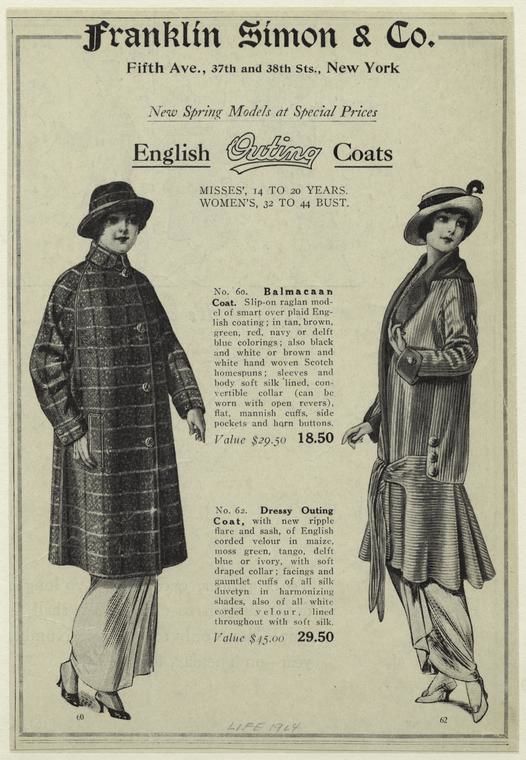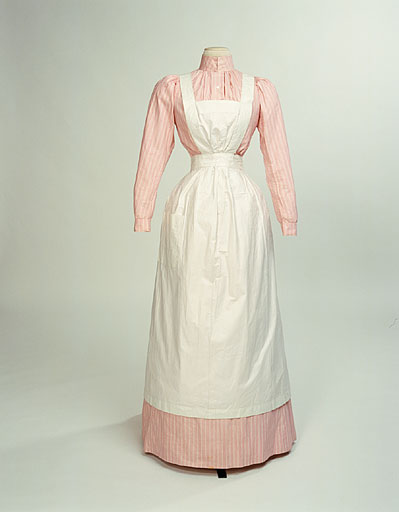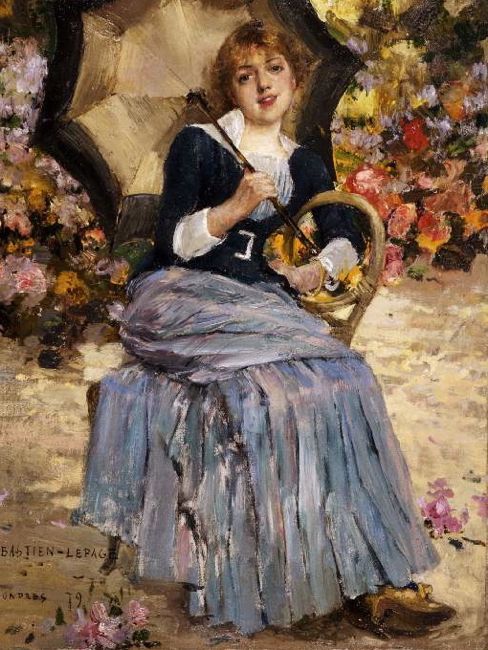The theme for the March Historical Sew Fortnightly Challenge is Protection: make something to protect yourself (from weather or injury) or your clothes (from soiling etc.).
The theme wasn’t my idea (and my apologies, but I can’t find my notes on who suggested it), but as soon as I saw it I thought “what a brilliant idea for a HSM challenge!”
Protection, after all, is the ultimate use for clothing. In its most basic form, it exists to protect us from the cold, or to shade us from the sun, to shield our skin in rough conditions, and to provide a barrier against injury in dangerous conditions.
Though it’s less common now, throughout much of history we also created garments to protect our clothing itself. So many garments were so expensive in time and cost to create and own that simpler, more economical clothes helped to shield the costlier garments from wear and use.
Examples of garments that protect us are cloaks, coats, gloves, hats, scarves and wraps worn for warmth; sunbonnets and large hats for sun-protection; functional armour; pudding caps for little ones; heavy work trousers and skirts.

English outing coats including a practical Balmacaan, 1914. Note the contrast of simplicity vs. elaboration with the two coats. Via the NYPL Digital Galleries
The most obvious garment that protects another garment is the apron, but many types of practical undergarments are also meant to protect the outer-garments from our own skin. And, of course, in addition to aprons, other forms of smocks and tunics were worn over better clothes by various professions throughout history. Things like gaiters (gaiters are practical, spats are decorative), puttee and the long cuffs worn by doctors and nurses are all garments that protect other garments (and, in the case of gaiters & puttee, also the wearer)

Cook’s dress: blouse & skirt with apron. 1890-1910, Manchester City Galleries
For this challenge, a garment that is for protection should have protection as its main function. Decorative papier mache armour of the late Renaissance was derived from a practical item for protection, but would be essentially useless at actually withstanding a blow from a weapon. Hats reduced to such a size, and so laden with decoration, that they do nothing to protect the head, keep it warm, or shield the face from the sun are clearly no longer about protection, nor are aprons of such elaborate trimmings and diminutive dimensions that they would expose most of the garment they are worn over to soiling and harm.

Girl with a Sunshade (Jeanne Samary), Jules Bastien Lepage, 1879

Thank you for exploring the possibilities of garments for protection. I think it is interesting how we can use garments to protect ourselves and also to protect are other garments.
oooo – thinking about dust ruffles, garment bags, sweatbands in hats…!
Yep! Now that you mention it, I’m not actually sure how old garment bags are at all. I’ve seen hatboxes and carry-bags from the 19th c, and lots of lingerie and laundry bags, but don’t think I’ve ever seen a garment bag earlier than the 50s. Definitely something that would need a bit of research!
I can add an extra 10 years back. My great aunt *definitely* had one in the 1940s when her wedding dress was taken from TX to NY, and it’s still in the family. Weren’t trunks used, with a sort of closet look when put on their sides? They would have been effectively garment bags.
I am re-reading Annette D’Ariaux’s Elegance book, written in the 1960s, and when she advises packing–even for extended boat travel including formal wear, she only mentions putting the formal dresses on the top of the packing pile in the suitcase, wrapped in tissue paper.
I take that back. It’s a newer bag. I forget the details of the dress’s journey…. Hmm…it definitely did not arrive in a trunk.
Here’s an awesome and intimidating trunk – sadly, if I recall correctly, it didn’t have an accompanying note saying how old it was or anything…
http://marmota-b.rajce.idnes.cz/Dacice_-_vystava_starych_satu_exhibition_of_old_clothes/#P1190721.jpg
Under-arm dress protectors could be a good small project, too.
Yes indeed!
My mind went a bit more of a similar way, and I thought: “Protecting clothes? Isn’t that what a chemise does?”
I actually plan to finally finish my bergere hat, but a chemise should work, too, shouldn’t it?
Yep, both of those should work!
OH, my… I’m actually already working on a number of things–will have to check dates/rules. “Leggings” (aka Spats/Gaiters), 1890s wool cape, need to put a facing on a skirt hem to protect from dirt…. and aprons are on the “some day” list, too~!
Man, this would be a great challenge for projects large and small. Even adding a bias tape to the bottom of a dress in order to catch the dirt when walking (and more easily replaced than cleaning an elaborate dress) would be in order. I like the idea of sweatbands and dress shields, too!
Local schools are allowed to borrow Stratford Festival costumes for a song–one rule: no deodorant!
Excellent, I’ll be able to do this challenge! Overall 2016 is shaping up to be not such a good HSM year for me, but I’ve got just the thing for Protection.
I don’t officially participate in HSM (no Facebook, no blog, no camera, no significant online presence), but I always enjoy watching and being inspired by the challenges and the amazing things people make!
As it happens, I’ve been thinking that I want to learn to make gloves this year, but my timetable just moved up because I accidentally left my favorite gloves somewhere yesterday and don’t expect to get them back. They were sweet vintage things, handsewn with a running stitch, and with a Bolton thumb that fit to perfection, and lapped seams from the pinky down the cuff. The overlapping edge had a scalloped edge that went from small scallops at the top of the pinky to big ones at the cuff, and had a tiny glass bead in each scallop! Wonderful little gloves… I’m sorry I lost them!
Anyway, it’s still chilly wear I live, so I think I shall make March my month for gloves!
And I have finished my entry for Protection. The 10606 hood from Herjolfsnes. No photos of it being worn yet, though.
http://matsukazesewing.blogspot.com/2016/02/norlund-78-hood-finished-project.html
Finished! I made a pair of chopines:
http://isabelladangelo.blogspot.com/2016/03/historical-sew-monthly-protection.html
A 1920s suit jacket: https://aboutmybuttonbox.wordpress.com/2016/03/25/sewing-by-the-sea-and-hsm-3/
Hello again… I finished my 18th cent apron for the #3 yesterday… http://marenshus.blogspot.de/2016/03/hsf-challenge-3.html
Hooray, I made a Victorian dress! It isn’t very protective, but I don’t want to drop out entirely, so I’m posting.
http://ajewintherain.blogspot.com/2016/03/35-by-35-no-22-victorian-wrapper.html
And a second project! Norse Shoes.
http://matsukazesewing.blogspot.com/2016/03/norse-shoes-second-pair.html
Finished! A smocked apron from 1535. This was such a fun project and the perfect thing to work on during down time at work!
http://wanderingdalbeth.blogspot.com/2016/03/hsm-march-2016-protection.html